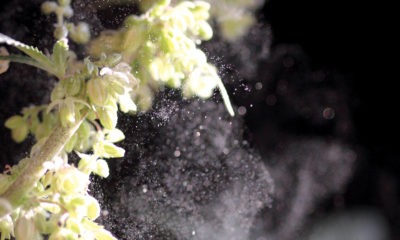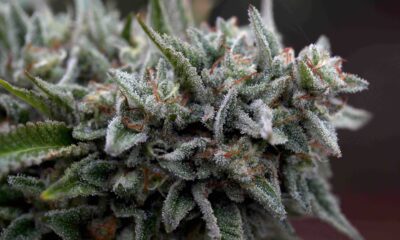
Cannabis
Tissue Culture & Synthetic Seeds: Buds Without Borders?
“Synthetic seeds” may sound like the stuff of science fiction, but some industry experts say — if it gets big enough — the cannabis cultivation industry might decide to use them. Could this be the far future of flowers?
Forward thinkers in the cannabis space are looking for ways to ensure that access to essential cannabis-based medicine is not defined by one’s zip code. And one answer — at least for the distant future of cannabis cultivation — might lie in tissue culturing and synthetic seeds.
Reggie Gaudino, vice president of scientific operations and director of intellectual property at Steep Hill Labs, has looked into these alternative methods for growing marijuana to see if they can potentially resolve a major stumbling block for cannabis distribution; the federal restrictions on transporting it from state to state.
Guadino said if you can find (and certify the genetics) of a strain that works for a particular malady, you still won’t be able to guarantee results under current cultivation technology.
“Here’s the problem; if you take the same genetics and you grow it five different ways you’ll get five different plants,” he said. “So it’s a combination of genetics and consistent growing conditions that give you a particular profile that is attractive to doctors or patients because it does certain things.”
The idea behind a tissue culture and a synthetic seed — essentially a tissue culture suspended within a bio-degradable, water-soluble capsule — is to propagate clones and provide an exact genetic copy of the original plant.
In the cannabis industry, cutting from a “mother plant” to produce a clone is common practice and works great within the current legal climate of cannabis, which continues to limit production to a relatively small scale. Tissue culturing and synthetic seeds are growing techniques that become advantageous on a larger scale, as it’s faster that clipping cuttings. The difference between the two would mean establishing tissue culture sites within each state, or transporting the plant material via a synthetic seed that can be placed directly into the growing medium.
According to Guadino, having genetic material or a germplasm that is not cannabinoid or plant-based might make it legal to be sent from place to place.
However, Nishan Karassik, the chief strategy officer at Phylos Bioscience, offered a different interpretation of the language in the Controlled Substances Act.
“Living plants can only be generated or ‘germinated’ from living tissue, even if it’s very small,” he said. “Germ cells or germplasm is living cell tissue from the plant from which new plants can be grown. This falls under ‘all parts of the plant Cannabis sativa L., whether growing or not.’”
But Phylos offers a genotype kit in order to test the true genetics of strains, and to participate in the service, participants send a sample of a cannabis stalk to Phylos — through the mail. What’s the difference?
“We use this portion of the law, ‘Such term does not include the mature stalks of such plant,’” Karassik said. “We also include instructions in our kit to wash the mature stalk in isopropyl alcohol in a specific way — this removes all cannabinoids from the stalk and thereby follows the controlled substances act and the DEA.”
While the laws of cannabis continue to shift across the nation, the potential for these advanced-growing techniques may develop within legal states as production increases.
“You take that tissue culture and the small tissue culture pellets and you put them on the right hormones and every one of them gives you a plant. And when you do it on a large scale, it becomes something that you can do very rapidly,” Gaudino said. “It’s way faster than trying to do cuttings and when you do it that way it does become a fairly economical way to do a large amount of scale up of a single genetic line.”
But he stressed that, at its current scale, the cannabis industry can’t benefit much from the technology.
“When you do it on a smaller scale and you don’t have the right tissue culture facility, it becomes not very efficient, not very cost effective and a very labor intensive method of cloning,” he said. “Realistically you’re probably no better off than getting a couple of really good mothers and taking care of them and then do cuttings that way.”
He also added that tissue culturing and the use of synthetic seeds are not widespread practices in agriculture, because Big Ag has yet to find a way for these man-made seeds to be as viable as regularly-made seed straight from the plant.
Synthetic seeds are used in some orchid production, an elite marketplace that supports the growing method due to the exceptional rarity of some types of orchids. For cannabis, ensuring this rareness becomes all the more complicated because so many strains are already hybrids. In addition, in the world of orchids, one could control the genetics of particularly unique variety by only providing access to female plants that cannot self cross.
“Here’s the problem with cannabis, cannabis can self-cross,” Gaudino said. “So if that’s the case, you stand a chance of loosing control of that genetic line in one or two generations anyway if, for whatever reason, it hermaphrodites or produces pollen when it shouldn’t.”
For his research at Steep Hill, Guadino went as far as purchasing the chemicals necessary to create synthetic seeds, but ultimately decided the process is not viable at this time.
“Cannabis is one of those things where if we had more information and we actually had a scalable agriculture built around cannabis, it might be different,” he said. “There’s really nothing proprietary yet about cannabis, because everybody, you know, has the clones and they sell them indiscriminately… The infrastructure that makes synthetic seeds really makes sense is if you have genetically distinct and identified strains and you have some level of proprietary understanding.”
For now, it appears these growing methods aren’t set to be a part of cannabis’ near commercial future, but one can continue to look towards what’s next for cultivators of the world’s most favored flower.
TELL US, would you use cannabis grown from synthetic seeds?






















